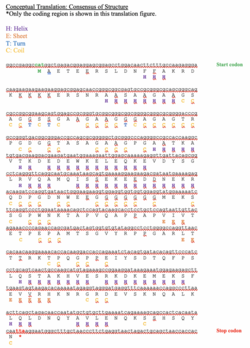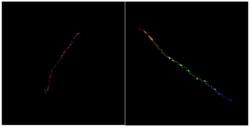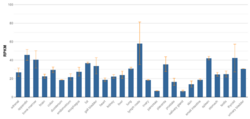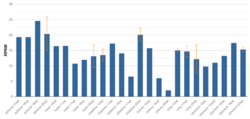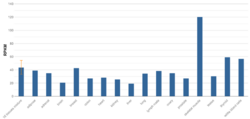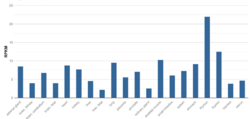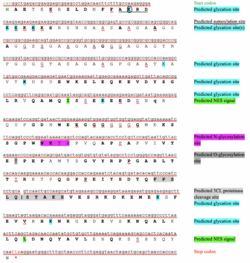Biology:CDV3 (gene)
 Generic protein structure example |
Protein CDV3 homolog also known as carnitine deficiency-associated gene expressed in ventricle 3 is a protein that in humans is encoded by the CDV3 gene.
CDV3 is a biomarker for hepatocellular carcinoma.[1] CDV3 has been considered as a potential target for gene therapy. Related gene families include plasma proteins and predicted intracellular proteins.[2]
Gene
Aliases
The CDV3 protein is also commonly known as tyrosine-phosphorylated protein 36 (TPP36). TPP36 isoforms have been found to be substrates of Abl tyrosine kinase.[3]
Locus
The CDV3 gene is on chromosome 3 (3q22.1).

Exons
There were variations in the listed number of exons in CDV3 between genetic databases. The number of exons vary based on the isoform in question, with most transcript isoforms having 5 exons.[4]
Span
The exons of human CDV3 gene's longest transcript isoform span 16,711 bp.[5]
Transcripts
Isoforms
CDV3 has seven isoforms,[4] and more are continuously added to databases as they are discovered. Currently there are isoforms a-f.
Protein
Molecular weight: 27.3 kD
Protein length: 258 aa
Isoelectric point: 5.89[6]
Motifs
A SAPS analysis[7] on the human CDV3 protein sequence found one uncharged cluster segment from 28-75 aa. There were no signs of high scoring hydrophobic segments. One high scoring transmembrane segment was found from 28-55 aa. CDV3 was found to have significant maximal spacing from 27-76 aa.
Repeats
The following repetitive structures were found for the protein.
Aligned matching blocks:
[45-52] AGAAGGGA
[66-73] AGAAGPGA
with superset:
[32-36] AGAAG
[45-49] AGAAG
[ 66- 70] AGAAG
______________________________
[134-137] MEKS
[213-216] MEKS
______________________________
Simple tandem repeat:
[31-43] AAGAA_GSAGGSSG
[44-54] AAGAAGGGAGA
Predicted Motifs
PROSITE found several potential motifs in CDV3.[8]
| Motif | Predicted Site (Base Pair Location) |
|---|---|
| Alanine-rich region: 28-77 | |
| Glycine-rich region: 33-72 | |
| Predicted protein kinase C (PKC) phosphorylation sites | 25-27, 107-109, 178-180, 179-181, 201-203, 207-209 |
| Casein kinase ii phosphorylation site | 79-82, 107-110, 207-210 |
| Tyrosine kinase phosphorylation site | 237-244 |
Predicted Secondary Structure
The following programs were used to develop this figure: JPred, CFSSP, and GOR4. The majority of the CDV3 structure is hypothesized to be alpha helices and random coil.
Predicted 3D Structure
The 3D structure of CDV3 was predicted through amino acid submission to the Zhang Lab and their I-TASSER program.
Gene regulation
Promoter
There are currently six different predicted promoters based on supporting transcripts. The following promoters were found using Genomatix . Promoter GXP_141972 was chosen for further analysis because of the large number of supporting transcripts, and it was found to be conserved in 14 of 14 orth. loci.
| Promoter Name | Coordinates | Size | # of Supporting Transcripts |
|---|---|---|---|
| GXP_141970 | 133585623 - 133586723 | 1101 | 1 |
| GXP_141972 | 133572563 - 133574180 | 1618 | 12 |
| GXP_141973 | 133587952 - 133589052 | 1101 | 1 |
| GXP_6749779 | 133573434 - 133574748 | 1315 | 13 |
| GXP_7542845 | 133569573 – 133574748 | 1101 | * |
| GXP_7542846 | 133583006 - 133584149 | 1144 | * |
*No transcript assigned.
Expression patterns
CDV3 is ubiquitously expressed, and at relatively high levels, in all tissues examined in the humans. Higher expression existed in certain diseases.
Gene profile
Various experiments showing expression of CDV3 demonstrated different patterns of tissue expression; however, it is concluded that the gene is expressed ubiquitously throughout all tissue types with more expression within tissues involved in the immune system and skeletal muscle tissue.[4]
The expression of CDV3 generally decreases throughout fetal development, but expression levels remain high.
Protein Level Regulation
A conceptual translation was made from NCBI reference sequence NM_017548.4. Amino acids conserved in at least 70% of vertebrate orthologous proteins are bolded (seen in the section below).
Evolution
Orthologs
The following orthologs were found through the NCBI database.[4] The date of divergence between species and Homo sapies was determined using TimeTree. The sequence identity and similarity were found using BLAST.
| Genus and Species | Common Name | Taxonomic Group | Date of Divergence (Median Time) | Accession Number | Sequence Length (aa) | Sequence Identity | Sequence Similar |
|---|---|---|---|---|---|---|---|
| Homo sapiens | Human | Mammalia | 0 | Q9UKY7 | 258 | 100 | 100 |
| Macaca mulatta | Rhesus macaque | Mammalia | 28.1 | AFH33110 | 257 | 98 | 98 |
| Callithrix jacchus | Common marmoset | Mammalia | 42.6 | JAB08658 | 257 | 98 | 98 |
| Castor canadensis | American beaver | Mammalia | 88 | JAV41819 | 265 | 89 | 89 |
| Mus musculus | House mouse | Mammalia | 89.8 | Q4VAA2.2 | 281 | 73 | 79 |
| Lonchura striata domestica | Society finch | Bird | 320 | OWK55384 | 248 | 62 | 74 |
| Xenopus laevis | African clawed frog | Amphibia | 353 | NP_001080515 | 240 | 58 | 73 |
| Electrophorus electricus | Electric eel | Fish | 432 | XP_026860127 | 230 | 55 | 74 |
| Oryzias melastigma | Marine Medaka | Fish | 432 | XP_024136300 | 230 | 50 | 63 |
| Danio rerio | Zebrafish | Fish | 432 | NP_997886 | 236 | 48 | 59 |
Paralogs
No human paralogs were found for CDV3 GeneCards and GenesLikeMe databases through the Weizmann Institute of Science. There were not any other relevant sources when the Google Search was conducted.
Phylogenetic tree
A phylogenetic tree was developed from the species listed in the table above using "One Click Mode" on Phylogeny.fr.
Interacting proteins
| Interacting Protein | Sources Supporting the Interaction | Function | Common Tissues |
|---|---|---|---|
| MYC | IntAct,[9] mentha[10] | Family of regular genes and proto-oncongenes; code for transcription factors; persistently expressed in cancer | Uterus, cervix, leukemia, carcinoma |
| EWSR1 | mentha,[10] BioGRID[11] | EWS RNA-binding protein 1; EWS protein function is not fully understood | Brain, lymph, placenta, carcinoma, colon, cervix, liver, ubiquitous |
| RBM3 | mentha,[10] BioGRID[11] | RNA binding motif (RNP1, RNA recognition motif) protein 3 | Placenta, carcinoma, T-cell, cervix, liver, colon |
| U2AF2 | mentha,[10] BioGRID[11] | U2 small nuclear RNA auxiliary factor 2; necessary for splicing; non-snRNP protein | Lymph, carcinoma, colon, lymphoblast, cervix, T-cell, liver |
| ELAVL1 | mentha,[10] BioGRID[11] | ELAV like RNA binding protein 1; stabilizes ARE-containing mRNAs; associated with several diseases and cancer | Intestine, cervix, lymphoblast, carcinoma, T-cell, colon, brain, muscle, thymus, ubiquitous |
| Pr55 (Gag) | mentha,[10] BioGRID,[11] NCBI[12] | Many diverse functions such as assembly and virion maturation; vital to HIV life cycle; cellular biotinylated CDV3 mouse homolog was found to be incorporated into this particle | |
| PIAS2 | NCBI[4] | Encodes inhibitor of activated STAT family; aids in sumoylation of target proteins |
Clinical significance
As earlier in the article, CDV3 has been found to be expressed in patients with various cancers and HIV. CDV3 has also been found to interact with Pr55 in the HIV retrovirus. Without further testing in expression, it is hard to determine how levels alter depending on disease state or the role this gene plays in these illnesses.
References
- ↑ "The potential value of CDV3 in the prognosis evaluation in Hepatocellular carcinoma". Genes & Diseases 5 (2): 167–171. June 2018. doi:10.1016/j.gendis.2018.01.003. PMID 30258946.
- ↑ "Tissue expression of CDV3". The Human Protein Atlas. https://www.proteinatlas.org/ENSG00000091527.
- ↑ "Molecular cloning and characterization of TPP36 and its isoform TPP32, novel substrates of Abl tyrosine kinase". FEBS Letters 537 (1–3): 203–9. February 2003. doi:10.1016/S0014-5793(03)00127-3. PMID 12606058.
- ↑ 4.0 4.1 4.2 4.3 4.4 4.5 "CDV3 CDV3 homolog [Homo sapiens (human) - Gene - NCBI"]. https://www.ncbi.nlm.nih.gov/gene/55573.
- ↑ "Nucleotide Links for Gene (Select 55573) - Nucleotide - NCBI". https://www.ncbi.nlm.nih.gov/nuccore?LinkName=gene_nuccore&from_uid=55573.
- ↑ "IPC - Isoelectric Point Calculator". Biology Direct 11 (1): 55. October 2016. doi:10.1186/s13062-016-0159-9. PMID 27769290.
- ↑ "SAPS < Sequence Statistics < EMBL-EBI". https://www.ebi.ac.uk/Tools/seqstats/saps/.
- ↑ Figure 4—figure supplement 2. Additional analysis of BioID hits.. doi:10.7554/elife.20882.011.
- ↑ "interaction_id:EBI-3962281". https://www.ebi.ac.uk/intact/interaction/EBI-3962281.
- ↑ 10.0 10.1 10.2 10.3 10.4 10.5 "Results - mentha: the interactome browser". https://mentha.uniroma2.it/result.php#CDV3.
- ↑ 11.0 11.1 11.2 11.3 11.4 "CDV3 Result Summary | BioGRID". https://thebiogrid.org/120726/summary/homo-sapiens/cdv3.html.
- ↑ "CDV3 CDV3 homolog [Homo sapiens (human) - Gene - NCBI"]. https://www.ncbi.nlm.nih.gov/gene?Db=gene&Cmd=DetailsSearch&Term=55573#HIV-1-interactions.
 |
